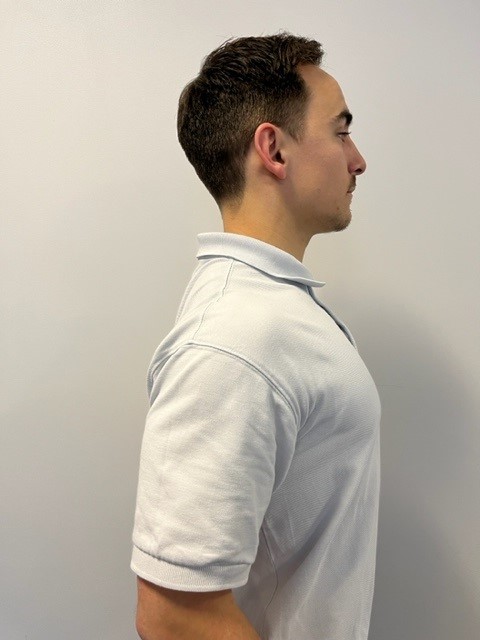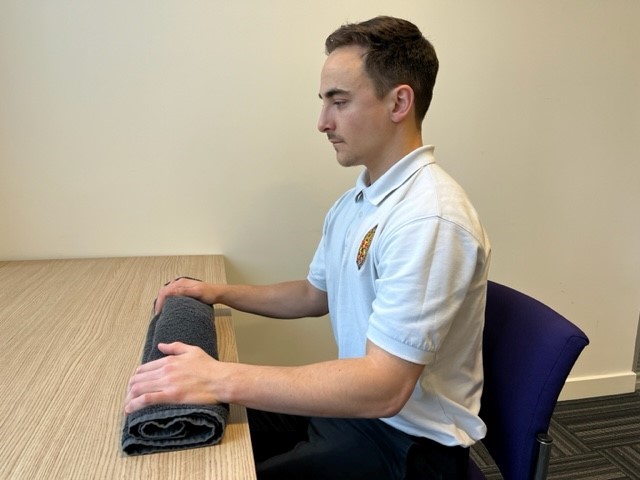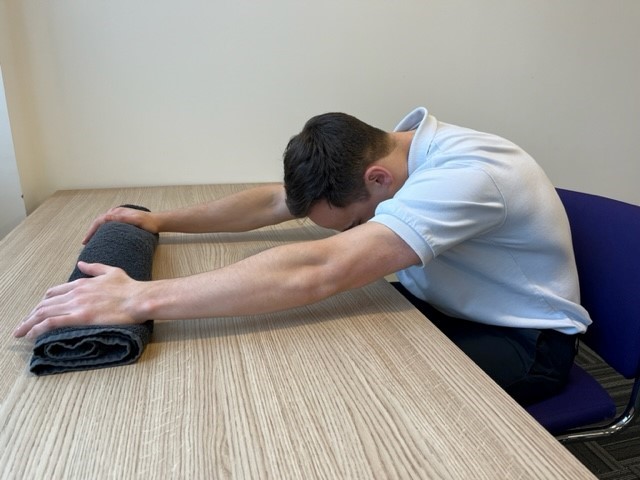On this page
- You should seek urgent medical advice if any of the following applies to you:
- What can I do to help my symptoms?
- Pain relief
- Cold or hot packs
- Avoiding aggravating activities
- Get a good night’s sleep
- Exercises
- What about work?
- What should I do if I am still experiencing problems?
- Further information
The shoulder joint is designed to give a large amount of movement. There are various structures that help to keep the joint in position:
- Ligaments and joint capsule which hold the bones together.
- A rim of cartilage (labrum) which deepens the socket.
- Muscles particularly the rotator cuff which keep the joint in the correct position when moving the arm.
Rotator Cuff Related Shoulder Pain is one of the most common causes of shoulder pain. The gap between the top of the arm bone (humeral head) and the top of the socket (acromion) is called the ‘subacromial space’. The rotator cuff tendons and a fluid filled cushion (bursa) are found in this space.
These structures can become painful if they are overworked or even under worked! Poor posture and using the arm in awkward positions can contribute to these problems, as can structural changes to the tendons or the surrounding bone.
You should seek urgent medical advice if any of the following applies to you:
- If you have had an injury to your shoulder that has caused pain and weakness and you are unable to lift your arm up.
- You have noticed any unusual lumps or swelling around the neck, shoulder or arm.
- You have hot red skin in the region of pain, have a fever or are starting to feel unwell since your shoulder pain started.
- You have had a injury to the shoulder that has led to your shoulder having a different appearance or shape.
- You have pain that is getting worse or not improving despite taking painkillers and doing the recommended exercises, or you have pain that is so severe that it prevents you from doing the exercises.
What can I do to help my symptoms?
Pain relief
Simple analgesia such as Paracetamol and an anti-inflammatory such as Ibuprofen can be very effective for the treatment of shoulder pain. You can obtain advice regarding medication from your local pharmacist or GP but remember to read the packet; and do not take over the recommended dosage.
Cold or hot packs
If the shoulder feels better, it will move better. Some people find applying a warm or cold compress to the area helps. A cold or hot pack can be helpful in offering symptomatic relief but must not be directly applied to the skin or to areas of skin that have poor sensation or are numb. A layer of protection (e.g. towel) should be used to cover the cold or hot pack so that it is not in direct contact with the skin.
Do not use ice or heat if you have circulatory problems, such as Raynaud’s disease, history of cold induced hypertension, peripheral vascular disease, allergy to cold (urticaria, joint pain) or sickle cell anaemia.
If your skin is usually numb over the injured area, please speak to your physiotherapist or GP before using a hot or cold pack / ice.
Ice must be used correctly otherwise ice burns can occur. Please see the instructions below:
- Start by wetting a cloth under a cold tap and then wring the cloth out until it is just damp.
- Place the damp cloth over affected area and then place either a plastic bag of crushed ice or a packet of frozen peas on top of the cloth. (The ice should be in small pieces in order to mould better to the area and help prevent ice burns).
- Leave the ice pack and cloth in place for approximately 10-15 minutes and repeat 3 to 4 times a day.
It is normal for your skin to go slightly red or pink. Remove the ice if extreme redness/pain, blistering or an increase in swelling occurs. If this does occur, please call NHS Direct for further advice.
Avoiding aggravating activities
It is often easier and less painful if you use your arms close to your sides and avoid lifting objects at arms-length. Avoiding reaching above shoulder height or behind you for a little while can help to settle the pain.
Get a good night’s sleep
During the night our bodies rest and repair. The better we sleep the quicker we get better. Supporting the painful shoulder by lying on your opposite side, placing a pillow behind you and hugging a pillow with the painful arm can help prevent rolling onto the sore side or sleeping in funny positions. Alternatively lying on your back with a pillow under your arm may help to support the shoulder.
Exercises
The exercises on the next page may be a good place to start but should be pain free when performed. They can be done regularly during the day. Remember to only move as far as you can comfortably.
Do not continue the exercises if they significantly increase your pain or swelling. If this were to occur, please see your GP / Physiotherapist for further advice.

Exercise 1 – shoulder retraction
In sitting or standing squeeze your shoulders blades together.
Repeat 10 times.

Exercise 2 – walkaways
Stand with one foot forward. Place your hands on the table.
Walk slowly backwards, keeping your hands on the table. Keep your neck and back straight. Stop when you feel a comfortable stretch in your shoulder.
Hold 10 seconds, repeat 5 times.

Exercise 3 – table slides
In sitting or standing with the palms of your hands flat on a tavle top. Slide your hands forward and back along a smooth surface.

Only move within your comfortable range. You can use a towel under your hands to allow easy movement.
Repeat 10 times.
What about work?
Maintaining all normal activities including work improves your chance of recovery by keeping you moving. This helps you keep your ‘work fitness’ and prevents your shoulder getting weak, which can prolong your pain.
You do not have to be pain free to return to or remain at work.
It may be necessary to do temporary lighter or modified duties. This should be discussed with your line manager initially. If further clarification is needed your Occupational Health advisor can identify more specific role modifications.
What should I do if I am still experiencing problems?
If you are unable to agree on restricted roles with you manager or you are still having problems (despite following this advice): your occupational health team can help.
The occupational health team can advise you on how to bridge the gap to help you return to normal activities. You can also gain access to the occupational health physiotherapy team by:
Self-referral portal
Staff can self-refer into Newcastle Occupational Health Service by completing an online self-referral.
The online referral portal will replace the downloadable self-referral forms that staff have previously completed and emailed across to the service.
Find out more and for further help in completing a self-referral.
Management referral
Management referrals will be completed and processed using an online system which we will be launching soon.
We will be contacting managers shortly in order to onboard them onto the system.